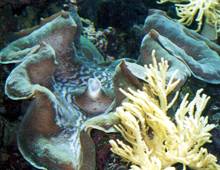Description: Giant clams (Tridacna gigas) have four or five large, inward, vertical folds in their thick, heavy shell. The shell does not have scutes and consists of two valves. Once they are fully grown they cannot close their shell completely. The mantle is usually yellow, golden brown or green, with many iridescent blue, purple, or green spots. They also have a number of pale or clear spots on the mantle, known as ‘windows’. These ‘windows’ allow sunlight to filter in through the mantle which is necessary for photosynthesis. The mantle is fused except for the two siphons (holes), an inhalant siphon and an exhalant siphon. The inhalant siphon is used to draw in seawater that is then filtered for planktonic food. The exhalant siphon is used to expel water during spawning. No two Giant clams have the same coloration.
Size: This is the largest living bivalve mollusk. The shell can reach up to 59 inches (1.5 m) in length and the clam can weigh more than 500 pounds (249 kg).
Behavior: Giant clams are sessile, once they have settled somewhere they remain there for the rest of their life and within their environment it is not uncommon for them to live more than 100 years!
Diet: Using its siphon, the Giant clam filters particulate food, including microscopic marine plants (phytoplankton) and animals (zooplankton). However, the majority of its nutrients are obtained by a mutually beneficial relationship with billions of algae that live in its tissues. The algae gain protection from predators and the clam obtains the carbon by-products of photosynthesis.
Reproduction: Giant clams reproduce sexually by broadcast spawning. They release eggs and sperm into the water, where the eggs are fertilized. Fertilization takes place in open water and is followed by a planktonic larval stage. The larvae swim and feed in the water column until they are big enough to find somewhere to settle and then they begin their adult life as a sessile clam.
Habitat/range: They are commonly found in reef flats and shallow lagoons in the warm waters of the South Pacific and Indian Oceans.
Status: Tridacna gigas is listed as Vulnerable on the IUCN Red List.



